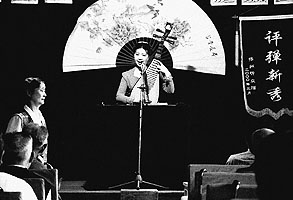Professional Storytelling (1)
The performed narrative arts of China—quyi

Chinese oral and performing literature, as it exists today, is generally divided into two main categories: drama/opera xiqu, and performed narrative arts quyi. Quyi, a term which gained currency only after 1949, is almost synonymous with the former, more descriptive expression 'telling and singing arts' shuochang yishu. Both drama and quyi are professional arts whose performers make a living from their skill or at least are given remuneration for their performances. The fact that those arts are also sometimes practised by amateurs does not basically change their status in this respect. Oral arts which accompany daily life in a non-professional way, like folksongs, worksongs, jokes, riddles, sayings, nursery rhymes, etc., are thus excluded from the sphere of quyi, though they often constitute elements of the quyi genres. The term is none the less broad: It covers a wealth of different and locally founded genres of professionally performed oral arts-about 300 genres are currently registered among the 56 nationalities of China-based mainly on the telling of stories, singing of ballads/lyrics or a combination of both.
Yangzhou balladesinging video (mpeg 4.355Kb)
Yangzhou balladesinging video (wmv 1.333Kb)